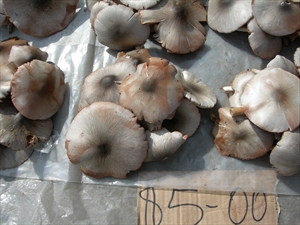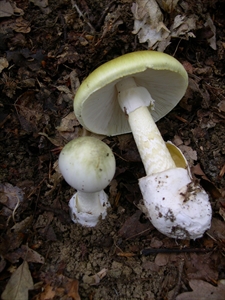- Widespread. East and Southeast Asia, and introduced in many other regions, including Africa, North America, Australia. In Solomon Islands.
- Not a pest, an edible mushroom. In button stage similar to highly poisonous death cap, Aminata phalloides, which causes liver and kidney failure.
- Found naturally on wood chip piles, garden soil, compost heaps and, in Pacific island countries, on decaying sago palm trunks and empty oil palm fruit bunches. Commonly grown commercially on rice straw beds and picked immature before greyish-brown veil ruptures leaving the torn volva at the base. Sold fresh, canned or dried.
- Cap 5-12 cm diameter, broadly convex or bell-shaped, dark grey in centre, becoming silvery-white or brownish-grey towards margins, radially streaked with soft hairs. Tends to split at edges. Gills free from stem, brownish-pink. Stem 6-12 cm, whitish or brown.
- Differences from death cap: (i) pink spore print – death cap white; (ii) no ring on stem – death cap has white membranous ring; (iii) different distributions - but common hosts for death cap (oak, chestnut and pine) have been moved around the word (with the fungus).
- NOTE, THE TWO FUNGI CANNOT BE DISTINGUISHED IN THE BUTTON STAGE.








